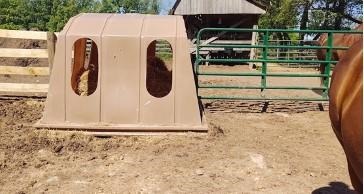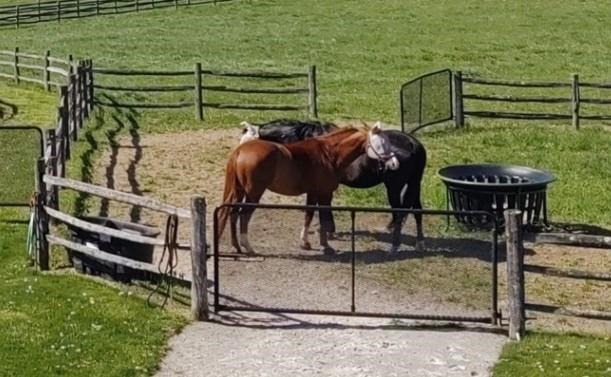
Large bale free-choice style feeder (Hay Hut).

Small bale free-choice style feeder (basket feeder).
Hay Feeder Use and Benefits
Wastage and Economic Loss
One major benefit to using a hay feeder is that it reduces the amount of hay lost due to waste. A study conducted at the University of Minnesota found that using round bale feeders results in significantly less hay wasted by horses. Nine different commercial round bale feeders were all found to reduce hay waste when compared to round bales fed directly on the ground. When the bales were fed on the ground, researchers found that 57% of the hay was wasted, compared with 5-33% hay waste when using different types of hay feeders. Furthermore, financially the feeders paid for themselves in 1-20 months when the amount of hay that would have been lost without the use of the feeder was considered. More details about this study are available on the University of Minnesota website. A similar horse study was conducted at Sam Houston State University with round bales and ring feeders (a specific type of round bale feeder). When hay was fed in a ring feeder, only 5.5% of the hay was wasted, but when the hay was fed without a ring feeder, about 35% of the hay was wasted. Another study at the University of Minnesota (read more) found that when hay was fed in small square bale feeders (such as basket, slat, and bunk feeders), less hay wastage occurred (1-5% wastage) compared to when horses were fed hay on the ground (13%). Because hay (and money) was saved with the use of any type of small square bale feeder, the feeders paid for themselves between 9-12 months. While hay wastage when feeding from small bales has been observed to be lower than that from round bales, it is clear that hay feeders can reduce the waste of hay in your pastures and dry lots no matter the size of hay bale you plan to feed.
The online survey of Pennsylvania equine caretakers found that the size of hay bale being fed appeared to affect whether a hay feeder was used or not (Table 1). When caretakers fed large bales (round or square), hay feeders were used on average by 58% of horse caretakers (it ranged from 37% to 79% depending on if the hay was fed in a stall, dry lot, or pasture). However, when feeding small square bales or flakes, only 34% of caretakers used a hay feeder (it ranged from 31% to 37% depending on if the hay was fed in a stall, dry lot, or pasture). This wide range in use of hay feeders in Pennsylvania, particularly for large bales, may be due to the fact that these bales were fed in a variety of locations on the farm. The finding that more caretakers used feeders when feeding from large bales was interesting since feeding small square bales in hay feeders has also been found to significantly reduce hay waste.
| Location | Type of Bale/Flake Offered | Percent of caretakers using a hay feeder |
| Pasture | Large Bale | 79% |
| Pasture | Small Bale/Flakes | 39% |
| Dry Lot | Large Bale | 37% |
| Dry Lot | Smale Bale/Flakes | 30% |
Table 1. Table displaying the percent of horses who were fed hay in a feeder depending on if they were fed large or small bales and the location.
Health Considerations
Not only does the use of hay feeders save money but they can also decrease the risk of horses consuming spoiled hay, which might cause gastrointestinal issues. This is particularly true when feeding from large bales outside. When horses eat from bales of hay placed directly on the ground without a hay feeder, the amount of hay waste is high because horses will pull large amounts from the bales and then drop some of it on the ground. The hay then becomes trampled and contaminated with urine and manure. If consumed, horses may experience digestive upset and other health-related issues. The combination of horse feces and hay waste may also create an ideal environment for filth fly development, increasing the number of flies on that horse farm, which is a common nuisance for horse owners.
Additionally, not protecting the hay in a feeder with a roof can leave hay exposed to rain and moisture which may encourage mold growth. Consuming moldy hay can lead to a number of respiratory and digestive issues in horses. Feeders should be cleaned regularly to avoid mold growth on any remaining fine pieces of hay. Properly using hay feeders decreases the risk of horses consuming spoiled hay and protects horse health.
Recently, there has been speculation that the height of the hay placement may affect horse health. Horses consuming hay with a high head and neck posture has been proposed to suffer detrimental health issues. This could happen, for example, when tying hay nets above the horse's head in the stall or trailer. While studies have shown that feeding from hay nets at a position above the ground causes different back posture in horses, no negative effects other than an unnatural feeding posture have been found to date. Tying hay nets at or below head level or using feeders that are placed on the ground will better simulate natural posture in horses but could pose a risk of legs or shoes getting caught in the net. Generally, feeders for large bales are designed to sit lower to the ground, which allows horses to eat in a more natural head and neck position.
Hay feeders can also raise concerns with regards to dental health. Choose hayfeeders that do not involve horses' teeth coming into contact with metal grating as this can damage or wear teeth. For example, when choosing a restricted access/slow feeder, use one that has soft mesh. Regular upkeep of feeders will ensure that horses do not accidentally hurt themselves on any sharp edges.
Conclusion
The use of hay feeders when providing any amount of hay to horses helps to prevent hay wastage, reduce the risk of horses consuming contaminated hay, and can save caretakers money. Therefore, it may be something that horse owners should consider implementing to make the most of their horse hay supply.
Source : psu.edu